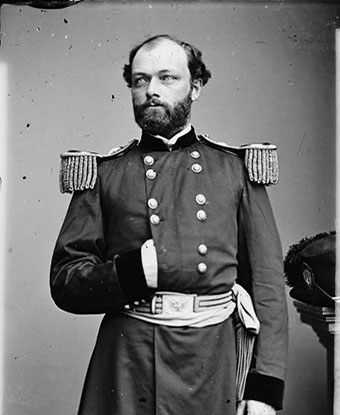Last updated: December 1, 2019
Person
Quincy A. Gillmore

Library of Congress
Quincy Adams Gillmore, named after President John Quincy Adams, graduated first in his class at West Point in 1849. Commissioned into the Corps of Engineers, Gillmore worked on coastal fortifications in Hampton Roads, Virginia. His application of his knowledge of engineering and artillery later brought him fame during the Civil War as an Union general.
At the start of the Civil War, Gillmore served on the staff of General Thomas W. Sherman, accompanying him on the seizure of Port Royal, South Carolina in 1861. Afterwards, Gillmore received an independent command: the Siege of Fort Pulaski, a Third System coastal fort on Tybee Island, near Savannah, Georgia. Gillmore became the first general to use massed rifled artillery to reduce a masonry fort at long range. The fort surrendered after five thousand rifled shells breached its walls. Previously impregnable against smoothbore fire, rifled artillery made quick work of masonry. The days of brick fortifications were numbered.
Gillmore’s triumph at Fort Pulaski catapulted him to brigadier general and the command of the Department of the South, which included South Carolina. The Union military, both the US Army and US Navy, set Charleston, the cradle of secession, in its sights in 1863. Gillmore commanded the Union army’s land campaign on Morris Island. Frontal infantry assaults against Battery Wagner failed to dislodge the Confederates, resulting in the fame of the 54th Massachusetts Regiment and thousands of casualties.
Recognizing the human cost of additional assaults, the Union advanced by digging trenches and moving heavy guns closer to Confederate positions, pouring withering fire into Battery Wagner. The campaign on Morris Island foreshadowed the horrors of modern wars like World War I with the use of aerial reconnaissance from Confederate balloons, Union calcium lights illuminating nighttime bombardments, the use of wire obstructions, and the use of the rapid-fire Billinghurst Requa Battery gun. By early September 1863, the Confederates abandoned Morris Island.
The momentum of the campaign stalled, and the Union failed to use Morris Island as a springboard to capture more land around Charleston Harbor. Gillmore did, however, use rifled artillery on Morris Island to bombard Fort Sumter and Charleston, prompting the protest of Confederate General Beauregard. Gillmore earned the dubious distinction of being one of the first military commanders to direct artillery fire at a civilian center.
In May 1864, General Gillmore’s X Corps was transferred to the Army of the James in Virginia and fought in the failed Bermuda Hundred Operations. After the Union defeat, Gillmore asked to be transferred and found himself in Washington D.C., where he raised thousands of recruits to defend the capital in 1864 against Confederate General Jubal A. Early’s advancing army.
After the war, Gillmore continued a successful career as an engineer. He died in New York in 1888.
